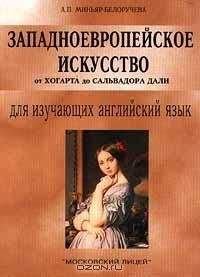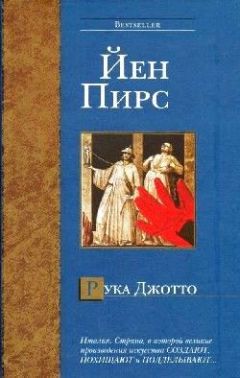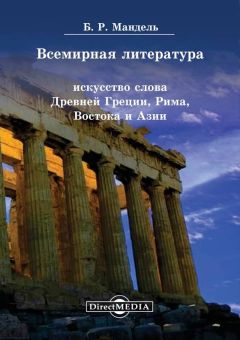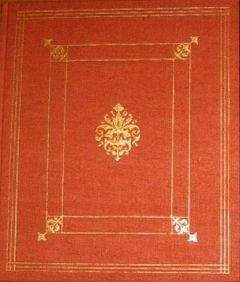А. Миньяр-Белоручева - Западноевропейское искусство от Джотто до Рембрандта
5. What is represented in the Birth of Venus? What gods are depicted in this painting? What do they do? Where is Venus placed? How is Venus proportioned? What differs Botticelli's Venus from the splendid Venuses of classical antiquity? What did Botticelli try to reconcile in the Birth of Venus?
6. What does the Mystic Nativity exemplify? What device did Botticelli use to emphasize the importance of the Madonna and the Child?
7. Whose pictorial style did Botticelli influence?
III. I. Give Russian equivalents of the following phrases:
poetic (scientific) current; early in life; celebrated pictures; to give up painting; to pursue the nymph; to spread blossoms from the folds; sloping shoulders; a complex allegory; a mature work; on canvas; on panel; in the fresco; in the picture; companion pieces; lovely creatures; drapery folds; an interweaving of linear patterns; classical antiquity; to interpret in different ways; delicate faces; attenuated figures; to be aloof from; transparent garments; a withdrawal from naturalism; wafted to the shore by the wind-god; to reconcile a pagan legend with the Christian tradition; spread a cloak around Venus; to stand in the cockleshell; V-shaped marks for waves; to paint the sea without concern for space.
II. Give English equivalents of the following phrases:
ведущий художник; научное (романтическое) направление; парные работы; знаменитые картины; на холсте; на доске; на картине; на фреске; на рисунке; отход от натурализма; проповеди; разбрасывать цветы; примирить языческую легенду с христианской традицией; зрелая работа; прозрачные одежды; трактовать по-разному; легко касаться земли; перестать писать картины; стилизованный берег; галочки вместо волн; фигуры необыкновенно воздушны; преследовать нимфу; влекомая к берегу; легко стоять в раковине; утонченные лица; переплетение линий; последователь к-л.
III. Make up sentences ofyour own with the given phrases.
IV. Translate the following groups of words into Russian:
Christian – Christianize – Christianity – christianized; reconcile – reconciliation; baptism – Baptist – baptize; reside – residence -resident; preach – preaching – preacher; aloof- aloofness.
V. Arrange the following in the pairs of synonyms:
a) aloof; current; pagan; give up; to dispel; to strew; attenuated; transparent; transform; reconcile; pursue;
b) heathen; trend; distant; translucent; to disperse; to scatter; lengthy; abandon; to transfigure; chase; appease.
IV. Match the names of the gods and goddess with their responsibilities.
Venus (Aphrodite); The Three Graces; Mercury (Hermis); Zephyrus; The Hours (The Horae); Flora
1) the god of the west wind; 2) the goddess of flowering and blossoming plants, shown with a wreath of flowers in her hair; 3) goddesses of season, representing the different times of the year and of the day; 4) the goddess of beauty and love, she emerged from the sea-foam and the winds blew her to the coast of Cyprus; 5) the god of commerce and prophecy, the messenger of the gods and the bearer of the dead souls; 6) goddesses of grace and beauty, who appear in art.
V. Replace the expressions in italics in the following sentences with expressions from the text which have the same meaning.
1. Although Botticelli was not interested in science he was the leading local painter in Florence in the 1480s. 2. Savonarola's spiritual leadership had a great impact upon BotticellI. 3. After 1500 Botticelli abandoned painting at all. 4. Botticelli's most famous pieces are the Primavera and the Birth of Venus. 5. The two pictures were considered mate paintings. 6. At the left Mercury is dispersing small clouds from the golden fruit. 7. Botticelli's figures are very lengthy. 8. The Three Graces are depicted in translucent clothes. 9. Venus was blown to the coast of the sea by Zephyrus. 10. Botticelli endeavoured to appease the Christian tradition with the heathen legend.
VI. Match the names of gods and goddesses with the appropriate painting. Describe these works of art.
a. Venus
1. Primavera b. Flora
c. Zephyrus
d. Mercury
2. Birth of Venus e. The Three Graces
f. Hour
g. Chloris
VII. Translate the text into English.
Две наиболее прославленные картины Сандро Боттичелли «Весна» (ок. 1477-1478) и «Рождение Венеры» (ок. 1483-1484) находятся в галереи Уффици. Тема «Весны» трактуется неоднозначно. Одни считают, что на картине изображена в аллегорической форме свадьба Лоренцо Медичи, другие полагают, что картина навеяна поэзией. Боттичелли не разъясняет сюжет. В картине «Весна» в единую композицию соединены фигуры Весны, Мадонны, Меркурия, Трех Граций, нимфы. Зефира, которые изображены в чаще тенистой рощи. Лицо Весны, разбрасывающей из подола цветы, печально. В работе отчетливо видны все особенности письма Боттичелли: декоративность стиля, романтический характер образов, фантастический пейзаж, воздушные фигуры.
Боттичелли создал своеобразный женский тип: утонченные лица, удлиненные тела, покатые плечи. Фигуры кажутся бескровными и невесомыми, почти не касающимися земли. В картине «Рождение Венеры» Боттичелли изобразил прекрасную богиню. Рожденная из моря, под дуновением ветров в раковине Венера скользит по поверхности моря, написанного безотносительно пространства с галочками вместо волн, к чрезвычайно стилизованному берегу, на котором ее поджидает одна из Гор, готовая набросить на богиню плащ. Венера почти не касается раковины. Струящиеся волосы прикрывают ее наготу. В своих работах Боттичелли стремился примирить христианскую традицию с языческими мифами.
VIII. Summarize the text.
IX. Topics for discussion.
1. Botticelli as the precursor of the High Renaissance.
2. Savonarola's impact on BotticellI.
3. Botticelli's style and characters.
SUPPLEMENTARY READING
I. Read the text, retell it. Add whatever information you can. Here are some facts from the life of the gods of Olympus. But before reading the text learn the names of the gods.
Zeus – Зевс; Cronus – Крон; Rhea – Рея; Titans – Титаны; Tartarus – Тартар; Нега – Гера; Apollo – Аполлон; Muses – Музы; Artemis – Артемида; Hermis – Гермес; Aphrodite – Афродита; The Horae – Горы; Hephaestos – Гефест; Erinyes – Эйрена; Nike -Ника; Hebe – Геба; Ganymede – Ганимед; Themis – Фемида; Dike – Дике; Moirae – Мойры; Tyche – Тихэ
Zeus, the father of gods and humans, god of the sky, thunder and lightning reigns on Olympus. Zeus was the son of Cronus and Rhea. When he grew up he fought Cronus and the Titans and imprisoned his opponents in Tartarus. Zeus married Hera, and she became his lawful and perpetual wife. Countless gods and goddesses surround Zeus on Olympus. Among them are: Apollo, Artemis, Aphrodite, Hermis, Athena and others. Athena was always Zeus' favourite. She was born fully armed and shouting her dreaded war cry from the top of Zeus' head, which Hephaestus, his lame son, split open with an axe. The beautiful Horae guard the entrance to high Olympus. The gods feast in the golden halls erected by Hephaestus. Zeus sits on his throne, on both sides of which stand two goddesses: Erinyes, the goddess of peace, and Zeus' permanent associate, winged Nike, the goddess of Victory. When Hera enters the festival hall, all the gods render honours to her. She is the patron goddess of the family and married women. During the feasts the gods are served by Zeus' daughter Hebe, the goddess of youthful beauty, and Zeus' favourite cupbearer, Ganymede, the son of Tros, the king of Troy. Hebe and Ganymede bring the gods and goddesses ambrosia and nectar. The Three Graces and Nine Muses entertain the gods with their songs and dances. At these feasts the gods decide all matters and determine the fate of the world and of men. From Mount Olympus Zeus decrees laws; and Themis, the goddess of justice, and Dike, the defender of justice and truth, help Zeus to guard them. The fate of men is determined by three merciless Fates (goddesses of Destiny) – the Moirae. Nobody can escape their fate – neither gods nor mortals. The first goddess of Fate spins the thread of life, the second determines its length, and the third cuts off the thread of life. Tyche, one more goddess of Destiny, is the goddess of happiness and prosperity. From the Horn of Plenty, that suckled the infant Zeus, she pours gifts on men and happy is he who meets Tyche on his life-path.
Unit V Leonardo Da Vinci (1452-1519)
The coming of the sixteenth century saw the rise of great artists in Italy – Raphael, Michelangelo and Leonardo da VincI. Their names have never lost their enormous fame.
High Renaissance style was founded by one of the most gifted individuals ever born. Leonardo da Vinci, who has always been famous because of the fantastic range of his genius, fulfilled the Renaissance ideal of the Universal Man. He was not only a great painter and sculptor, but also an outstanding architect, an inventor, an engineer, a musician, and the leading physicist, botanist, anatomist, geologist and geographer of his time.
Leonardo's fame as an artist is based on eighteen paintings that came down to us, some of them incomplete, some damaged as a result of his experimental techniques. Leonardo's art surpassed the achievements of his time. In an era when the continuing power of the Church competed in men's mind with the revived authority of Classical antiquity, for Leonardo there was no authority higher than that of an eye, which he characterized as «the window of the soul». When Leonardo began his campaign to modernize painting the artist was still a craftsman and a guild member; before the High Renaissance was over, a great master could live like a prince.
Leonardo da Vinci was born in Tuscany. By 1469 he was Verrocchio's apprentice. In Verrocchio's workshop Leonardo obtained the best education of his time.
The Adoration of the Magi is Leonardo's first masterpiece. It was commissioned in 1481 for a church outside Florence. It was, never carried any further than the monochrome underpaint Leonardo used the pyramidal composition. The groups are based on the actions of the component figures and dissolve as soon as they move. Leonardo did not know it, but this discovery was made in Greece in the 5-th century B. C. In this work Leonardo started with the moment of feeling, form came next.
The Madonna of the Rocks, of 1483, is one of the earliest and the most famous Leonardo's pictures. It was intended for the Oratory of the Immaculate Conception in Milan. The doctrine of the Immaculate Conception means that the Virgin was freed from the taint of the Original Sin. Leonardo has interpreted this doctrine dramatically. He represented Mary in the midst of a dark world of rock forms. In this strange rocky grotto, where the sun never seems to strike and the plants grow thick but colourless, the Christ Child manifests his Divinity as he blesses the infant St. John, himself taken under the Virgin's protection. And, like a prophecy of the Baptism of Christ by St. John in the Jordan, a river winds away among the pale peaks. This painting makes Leonardo a typical artist of the High Renaissance.
The Madonna and Saint Anna was designed in Florence in 1501 and completed many years later in Milan. It represents a revolutionary rethinking of the conventional theme of the Holy Family. Leonardo intertwined the figures to form a pyramidal composition. Leonardo makes the Virgin sit on her mother's lap and merges their bodies in such a way that their heads are like twin heads rising from a single trunk. S. Anna's head mirrors her daughter's image. The Virgin, as in traditional representations of this subject, is shown reaching for the Christ Child, who in his turn attempts to ride upon a lamb, the symbol of his sacrificial death. The background is one of the most impressive mountain pictures ever painted. Valleys, rocks and peaks diminish progressively into the bluish haze of the distance until they can no longer be distinguished.
Leonardo's power as an artist and thinker is evident in the Last Supper and the Mona Lisa, his two most famous works. Leonardo's Last Supper was painted on the end wall of the refectory of the Monastery of Santa Maria delle Grazie in Milan in 1495. In the fresco Christ discloses to his followers that soon one of their number will betray him and their cause. The composition is the product of the moment of action and meaning. The Apostles are presented in four groups of three each. Each of these numbers has many meanings: the multiplication of the Gospels by the Trinity is only one, and twelve itself is not merely the number of the Apostles but of the months of the year and the hours of the day and of the night. The numerical division helps to throw the fundamental character of each of the Apostles into full relief, from the innocence of John on Christ's right to the horror of James on his left and to the protestation of Philip, who placed his hand on his breast. Only Judas knows, and the light does not shine upon his face. The Last Supper is a humanistic interpretation of the narrative. Leonardo has painted a higher reality, thus making a complete break with the Early Renaissance and establishing the ideal world in which Michelangelo and Raphael later operated. Leonardo painted his masterpiece in an oil-and-tempera emulsion on the dry plaster, and it began rapidly to peel off. As a result the surface is severely damaged.
Although Leonardo's paintings are badly preserved, they are all fascinating. Leonardo created an enigma to which he gives no answer.




